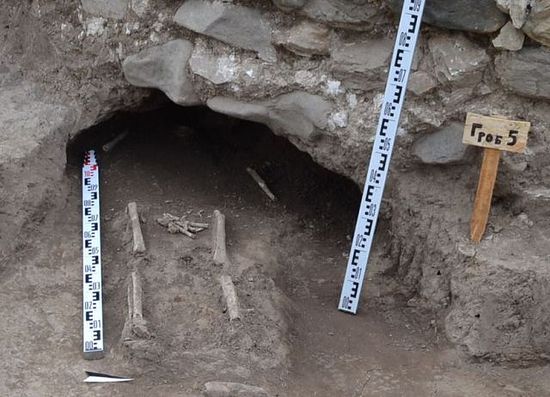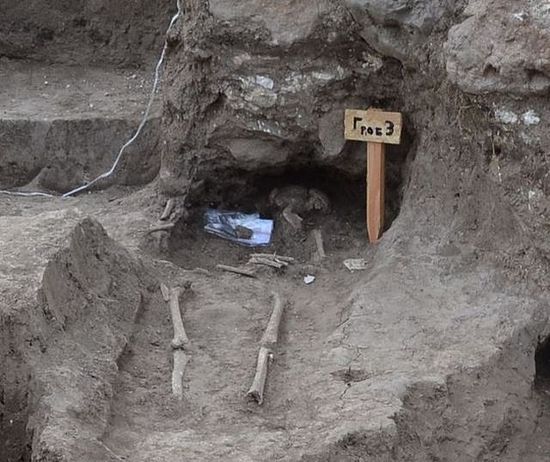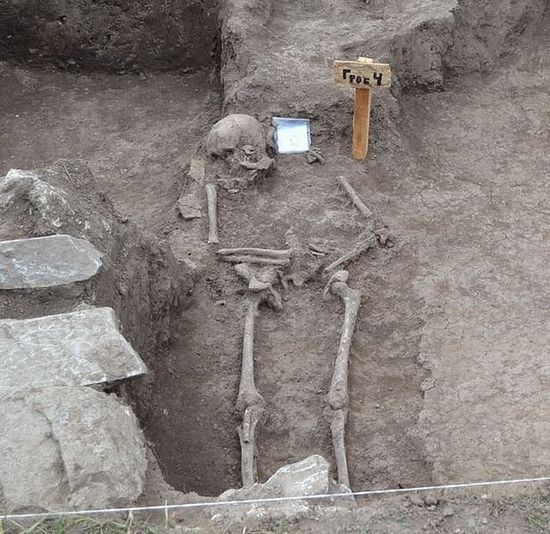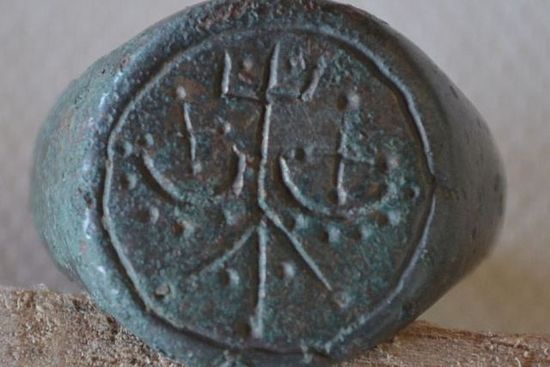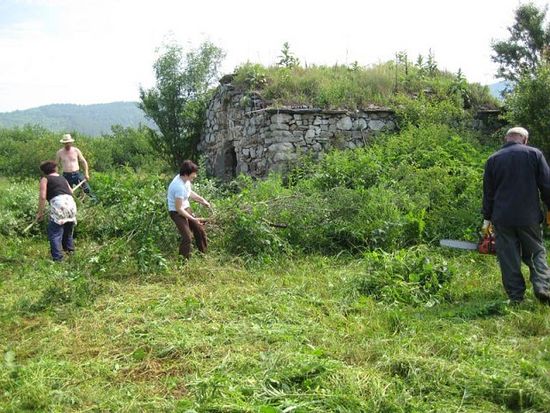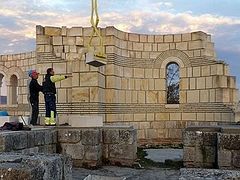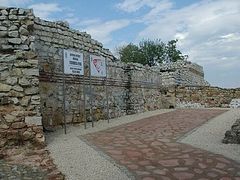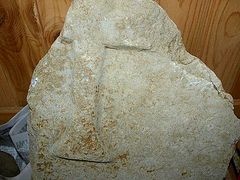Source: Archaeology in Bulgaria
June 5, 2016
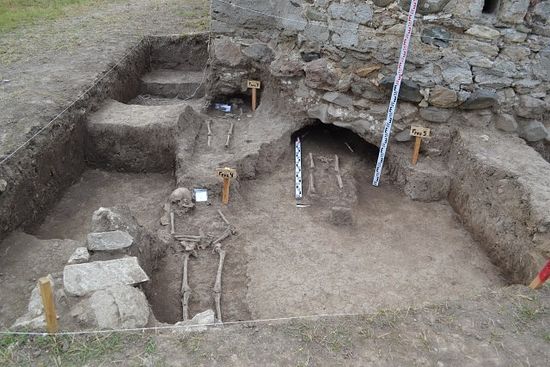 Several graves of medieval Bulgarian aristocrats from the House of Shishman (r. 1331-1395) have been discovered at & under the foundations of the stone church St. George near the town of Botevgrad. Photo: National Museum of History
Several graves of medieval Bulgarian aristocrats from the House of Shishman (r. 1331-1395) have been discovered at & under the foundations of the stone church St. George near the town of Botevgrad. Photo: National Museum of History
The grave of a female aristocrat from the Shishman Dynasty which ruled the Second Bulgarian Empire (1185-1396) in its last few decades before it was conquered by the Ottoman Turks has been discovered during the excavations of the old church St. George near the an old stone church is to be excavated near the town of Trudovets, Botevgrad Municipality, in Northwest Bulgaria.
The now defunct St. George stone church near Trudovets is believed to have been part of a medieval monastery, and still has fragments of medieval frescoes. On the archaeological site of the stone church, locals have found a marble pillar and Early Byzantine coins from the 5th-6th century, leading scholars to hypothesize that the monastery which existed there may have dated back to Early Christian times.
The discovery made by the team of archaeologist Filip Petrunov from Bulgaria’s National Museum of History in Sofia is manifold: the grave of the medieval Bulgarian princess was found literally “built into” the foundations of the old stone church; inside the grave, the researchers have found a rich inventory including a ring with the monogram of the Shishman Dynasty (r. 1331-1395); and, last but not least, the archaeologists have found evidence that in the Middle Ages the St. George Church near Trudovets was actually located on an island in the middle of a small lake which dried out after the 14th century.
The old stone church near Trudovets is not far from the Bozhenishki Urvich Fortress (not to be confused with the Urvich Fortress near Sofia), near the town of Bozhenitsa, which itself is situated 23 km to the north of today’s town of Botevgrad.
Not unlike the Urvich Fortress near Sofia, the Bozhenishki Urvich Fortress was used by Tsar Ivan Shishman (r. 1371-1395), the last Tsar of the Second Bulgarian Empire to be based in the capital Tarnovgrad (today’s Veliko Tarnovo) (the Empire was known as the Tarnovo Tsardom during his rule because of the secession of other Bulgarian feudal lords) in his resistance against the invading Ottoman Turks.
In its announcement about the discovery of the female aristocrat’s grave, Bulgaria’s National Museum of History says that the St. George Church was a temple–mausoleum for the local Bulgarian aristocracy in the 14th century.
The reason for this conclusion is that the presumed princess’s grave at the church is just one of a total of five graves found by the archaeologists.
The Museum also reminds of a well-known stone inscription found in the ruins of the Bozhenishki Urvich Fortress, the so called Bozhenishki Inscription, left by the governor of the fortress, Sebastos Ognyan, at the time of the Ottoman Turkish invasion of Bulgaria, and written by his scrivener Dragomir, which reads,
“I, Dragomir, wrote. I, Sebastos Ognyan, was a kephale (governor) under Tsar Ivan Shishman, and I endured great evil. During that time we fought the Turks. I held for Tsar Ivan Shishman’s faith."
The Museum also reminds that the feudal estates owned by the large family of what became the Shishman Dynasty, which came to power in the Second Bulgarian Empire in 1331 when Tsar Ival Alexander (r. 1331-1371) rose to the throne in Tarnovgrad, included territories in much of today’s Northwest Bulgaria and Eastern Serbia, i.e. from Belgrade to Vidin, to Lovech.
The newly discovered grave of a young princess proves that the Botevgrad Valley was also part of their estates because a ring found together with the other female adornments in the funeral inventory features a monogram of the Shishman family.
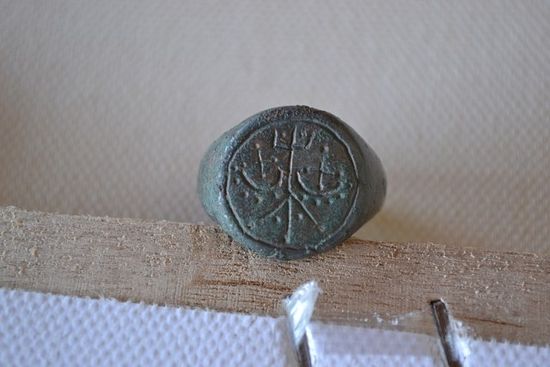 This ring with the monogram of the Shishman Dynasty found in one of the graves proves that the woman buried in it was a medieval Bulgarian princess. Photos: National Museum of History
This ring with the monogram of the Shishman Dynasty found in one of the graves proves that the woman buried in it was a medieval Bulgarian princess. Photos: National Museum of History
The medieval Bulgarian princess was buried wearing a head cloth with golden embroidery.
“We are now wondering how to restore [the cloth] because textiles are the most difficult matter to restore," he adds.
Dimitrov says that in his 45 years as a historian so far he has never seen a funeral like the one discovered in the foundations of the old stone church St. George near Trudovets.
“It is very weird. Stones had been removed from the foundations of the church, and the woman was buried under there. She was just “built-in"," he says reminding of the stories in Bulgarian folklore songs and tales about the «building-in" of people into buildings.
In his words, this custom has been perceived as a “figurative building-in" of people through their shadows.
“It has been thought that this custom was symbolic. This here is real," he concludes, adding that the archaeological team hopes to be able to identify more precisely the medieval female Bulgarian aristocrat buried under the St. George church near Botevgrad.
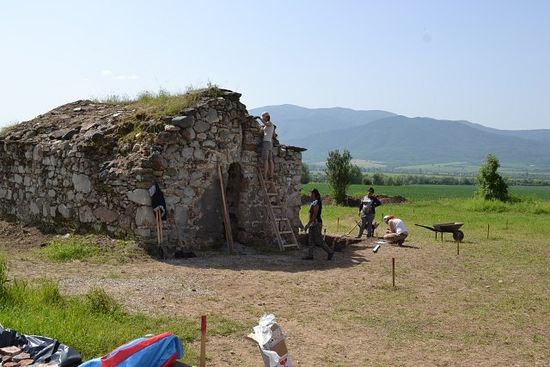 The St. George Church near Trudovets, Botevgrad Municipality, is in a dire need of restoration. Photo: National Museum of History
The St. George Church near Trudovets, Botevgrad Municipality, is in a dire need of restoration. Photo: National Museum of History
The excavations of the St. George Church have been funded with BGN 10,000 (app. EUR 5,000) by the b, and another BGN 10,000 provided by Botevgrad Municipality.
The archaeological excavations have been initiated by the local authorities wishing to save the old stone church whose walls have big cracks.
The building has been reinforced but is in need of all-out restoration, for which Botevgrad Municipality is going to draft a project once the digs are completed.
The St. George church near Trudovets has had a monument of culture status since the 1970s. Yet, up until 2013, when it was cleaned up by locals, the church had been almost completely covered with soil and vegetation.
Locals say that around 1900, an inscription dating from 1335 AD (i.e. the time of the Second Bulgarian Empire) was discovered on territory of what probably was an Early Christian and/or medieval monastery; however, it has not been saved.

